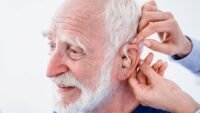The elderliness and chronic exposure to raucous noises according to hearing loss. Most types of hearing loss cannot be recovered however the quality of sound you hear can be improved via hearing aids. Hearing loss can be expounded as one of the three types- Conductive (involving the outer and middle ear), Sensorineural (inner ear), and Mixed (involves outer, middle, and inner).
Symptoms
The chief symptom of hearing loss is the inability of hearing noises, swaddling of speech, vexation with hearing consonants, withdrawal from conversations, and avoidance of social events. The earwax can block the ear canal and avert the conduction of sound propagation. Sound waves are measured in decibels. The contrivance of technology has no doubt made our lives easier but along with its precedence, there’s also a pitfall to it, its imprudent utilization can lead to problems like migraine, loss of eyesight, and hearing loss. We all love to watch and listen to music in our little world, but excessive utilization of these devices or in this case excessive use of earphones, earpods, and headphones is also a leading cause of hearing disability in youth. While enjoying the music, we get so much emerged in our little world that we forget the hold of the time.
Pioneering Of Hearing Aids
The pioneering discovery of hearing aids was done by Sir Miller Reece Hutchison during the latter half of the 18th century, he used the electric current to amplify weak signals. Around the beginning of the 19th century, the lucrative manufactured hearing aids were launched in the market. Back in those days, they were incommodious and were not handy. The technological advancement of miniaturization and the invention of the transistor was done during WWII which lead to decreasing size and portable hearing aids. Digital Hearing aids came to the market in the 1990s, and in 2010 Bluetooth-enabled devices were established.
Types
The sound-amplifying devices drafted to abet people with hearing impairment contain similar electronic components but they differ in the technology used to procure amplification, their design, and some special features such as earpieces to direct the sound propagation and enhance the sound quality. The preference for hearing aids is based on the type and severity of hearing loss, listening needs, and lifestyle.
Behind The Ear– aids [BTE aids], the parts of the aids are confined in a plastic case that rests behind the outer ear, the case is connected to the earpiece via a clear tube. These are easy to clean and handle and are relatively sturdy, often used for growing children so that their earpieces can be replaced as per the requirement.
Mini Byte- On-ear aid can be used via traditional methods like BTE aid but here the case and the earpiece are connected via an invisibly thin tube and have a comfortable earpiece for insertion. It not only shrinks the occlusion and plugged-up sensation but also addresses the cosmetic perturb for many end-users.
The Ear (ITE Aids)- is contained in the shell filling the outer part of the ear and is easier to handle as they are larger than in the canal aids.
In-The-Canal [ITC] Aids And Completely In-The-Canal Aids {CIC}- are contained in tiny cases that sit perfectly inside the canal of the ear and are the smallest hearing aids available and provide cosmetic and hearing advantages.
One need not worry about the unfashionably showing hearing aids and feel insecure about them showing. Technology has made it possible that it will not be even visible if you wear a hearing aid and probably with better sound qualities.




